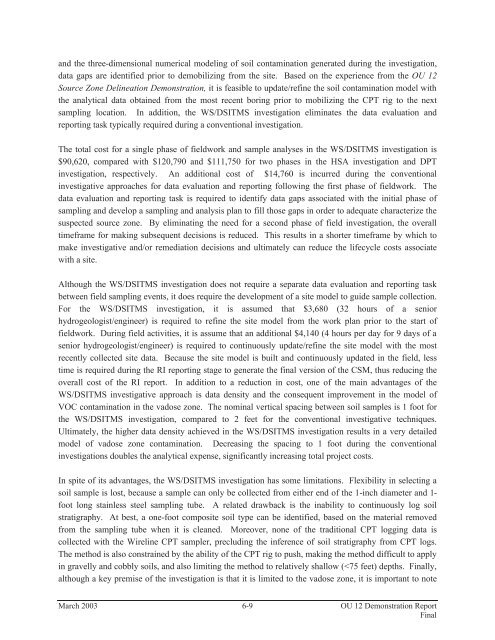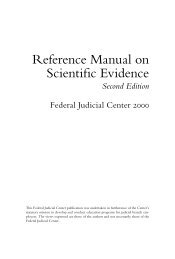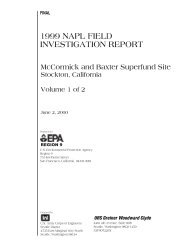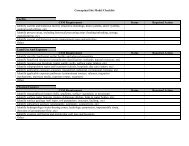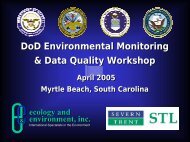Table 6-4. Estimated Cost for OU 12 Vadose <strong>Zone</strong> Investigation Using SVE/DSITMSTask Duration Quantity Unit Unit Cost Total Cost Assumptions(days)Project PlansDraft Work Plan 40 1 ls $20,000 $20,000 Assume standard cost and preparation time for project plans (WP, HASP, and SAP).USAF Review 30 --- --- --- --- Assume standard 30-day review cycle.Final Work Plan 21 1 ls $5,000 $5,000 Assume standard time and cost to respond to comments and modify project plans.Subtotal $25,000SVE InvestigationCoordination and Planning 5 40 hr $65 $2,600 Includes subcontractor coordinate, site preparation, utilities clearance, cleanup, and IDW disposal.Vapor Probe Well Installation 1- mobilization/demobilization --- 1.5 hr $110 $165 Assume local mobilization/demobilization cost.- DPT rig with operator --- 10 hr $140 $1,400 Assume seven 0.75-inch diameter vapor extraction wells installed from approx. 30 to 50 ft bgs.- field geologist --- 10 hr $65 $650 Assume 10 hrs for field geologist oversight.- materials --- 7 ea $250 $1,750 Assume $250 per well based on actual costs.SVE Process System Setup 4- field engineer --- 40 hr $85 $3,400 Assume 10 hrs per day for 4 days to construct skid-mounted SVE process system.- field geologist --- 40 hr $65 $2,600 Assume 10 hrs per day for 4 days to construct skid-mounted SVE process system.- materials --- 1 ls $1,000 $1,000 Includes 0.75-inch PVC piping, rotometers, and vacuum guages.SVE Operations 5- field engineer --- 60 hr $85 $5,100 Assumes 12 hrs per day for 5 days to conducted step tests at 7 locations.- field geologist --- 60 hr $65 $3,900 Assumes 12 hrs per day for 5 days to conducted step tests at 7 locations.- field generator and diesel --- 5 day $125 $625 Includes generator and diesel cost to operator blower 12 hrs per day for 5 days.- on-site laboratory analysis --- 5 day $3,500 $17,500 Analyses for TCE, PCE, DCE, and vinyl chloride; assumes no off-site confirmation analyses.- data evaluation --- 24 hr $115 $2,760 Assumes 24 hrs for engineer to evaluate SVE data and make recommendations for soil sampling.Subtotal $43,450Limited Soil InvestigationCoordination and Planning --- 8 hr $65 $520 Assumes addition 8 hrs of labor for coordination to transition from SVE to soil sampling.Sample Collection 3- mobilization/demobilization --- 1.5 hr $110 $165 Assume local mobilization/demobilization cost.- DPT rig with operator --- 36 hr $140 $5,040 Drill 6 locations to 60 ft bgs with sample collection every 2 ft starting at 20 ft bgs for a total of 20- drillers assistant --- 36 hr $45 $1,620 samples per location. Assume 2 locations per day = 3 days x 12 hr/day = 36 hrs.- field geologist --- 36 hr $65 $2,340 Assume 3 days x 12 hr/day = 36 hrs for field geologist to log cores and collect samples.- bentonite grout --- 12 bag $25 $300 Assume 2 bags of bentonite grout per location; 6 total locations.- on-site laboratory analysis --- 3 day $3,500 $10,500 Analyses for TCE, PCE, DCE, and vinyl chloride; assumes no off-site confirmation analyses.Subtotal $20,485Remedial Investion (RI) <strong>Report</strong>Update of CSM 10 48 hr $90 $4,320 Assume an average rate of $65/hr for geologist and $115/hr for hydrogeologist/engineer.Draft RI <strong>Report</strong> 30 120 hr $90 $10,800 Assume an average rate of $65/hr for geologist and $115/hr for hydrogeologist/engineer.USAF Review 30 --- --- --- --- Assume standard 30-day review cycle.Final RI <strong>Report</strong> 21 40 hr $90 $3,600 Assume an average rate of $65/hr for geologist and $115/hr for hydrogeologist/engineer.ERPIMS Data Package --- 48 hr $70 $3,360 No ERPIMS-formatted electronic data package from field lab but abbreviated analyte list.Subtotal $22,080IDW Disposal (Soil)Drum and Hazardous Waste Tranportation --- 1 ls $250 $250 Assume 40 gallons of TCE-contaminated soil generated during sampling.Hazardous Waste Disposal (Incineration) --- 525 lb $0.29 $152 Assume 525 lb TCE-contaminated soil per location using 2-inch diameter DPT rod, 40 ft totalRCRA State Tipping Fee --- 1 ton $28 $28 depth per location, and bulk soil density of 100 lb/cubic foot; 6 total locationsSubtotal $430Travel 35 hr $65 $2,275 Assume 1.5 hr/day for 13 days for field geologist and 10 days for field engineer.Subtotal 200 --- --- --- $113,720Project Management --- --- --- --- $11,372 Assume 10% of project subtotal cost for project management.Total $125,092March 2003 6-8OU 12 <strong>Demonstration</strong> <strong>Report</strong>Final
and the three-dimensional numerical modeling of soil contamination generated during the investigation,data gaps are identified prior to demobilizing from the site. Based on the experience from the OU 12<strong>Source</strong> <strong>Zone</strong> <strong>Delineation</strong> <strong>Demonstration</strong>, it is feasible to update/refine the soil contamination model withthe analytical data obtained from the most recent boring prior to mobilizing the CPT rig to the nextsampling location. In addition, the WS/DSITMS investigation eliminates the data evaluation andreporting task typically required during a conventional investigation.The total cost for a single phase of fieldwork and sample analyses in the WS/DSITMS investigation is$90,620, compared with $120,790 and $111,750 for two phases in the HSA investigation and DPTinvestigation, respectively. An additional cost of $14,760 is incurred during the conventionalinvestigative approaches for data evaluation and reporting following the first phase of fieldwork. Thedata evaluation and reporting task is required to identify data gaps associated with the initial phase ofsampling and develop a sampling and analysis plan to fill those gaps in order to adequate characterize thesuspected source zone. By eliminating the need for a second phase of field investigation, the overalltimeframe for making subsequent decisions is reduced. This results in a shorter timeframe by which tomake investigative and/or remediation decisions and ultimately can reduce the lifecycle costs associatewith a site.Although the WS/DSITMS investigation does not require a separate data evaluation and reporting taskbetween field sampling events, it does require the development of a site model to guide sample collection.For the WS/DSITMS investigation, it is assumed that $3,680 (32 hours of a seniorhydrogeologist/engineer) is required to refine the site model from the work plan prior to the start offieldwork. During field activities, it is assume that an additional $4,140 (4 hours per day for 9 days of asenior hydrogeologist/engineer) is required to continuously update/refine the site model with the mostrecently collected site data. Because the site model is built and continuously updated in the field, lesstime is required during the RI reporting stage to generate the final version of the CSM, thus reducing theoverall cost of the RI report. In addition to a reduction in cost, one of the main advantages of theWS/DSITMS investigative approach is data density and the consequent improvement in the model ofVOC contamination in the vadose zone. The nominal vertical spacing between soil samples is 1 foot forthe WS/DSITMS investigation, compared to 2 feet for the conventional investigative techniques.Ultimately, the higher data density achieved in the WS/DSITMS investigation results in a very detailedmodel of vadose zone contamination. Decreasing the spacing to 1 foot during the conventionalinvestigations doubles the analytical expense, significantly increasing total project costs.In spite of its advantages, the WS/DSITMS investigation has some limitations. Flexibility in selecting asoil sample is lost, because a sample can only be collected from either end of the 1-inch diameter and 1-foot long stainless steel sampling tube. A related drawback is the inability to continuously log soilstratigraphy. At best, a one-foot composite soil type can be identified, based on the material removedfrom the sampling tube when it is cleaned. Moreover, none of the traditional CPT logging data iscollected with the Wireline CPT sampler, precluding the inference of soil stratigraphy from CPT logs.The method is also constrained by the ability of the CPT rig to push, making the method difficult to applyin gravelly and cobbly soils, and also limiting the method to relatively shallow (
- Page 1 and 2:
FinalSource Zone Delineation Demons
- Page 3 and 4:
EXECUTIVE SUMMARYThis report docume
- Page 5:
The SVE demonstration conducted in
- Page 8 and 9:
TABLE OF CONTENTSEXECUTIVE SUMMARY
- Page 10 and 11:
LIST OF FIGURESFigure ES-1 Iso-Conc
- Page 12 and 13:
Figure 5-38 Horizontal slices at fi
- Page 14 and 15:
LIST OF ACRONYMS AND ABBREVIATIONSA
- Page 16 and 17:
Hill Air Force BaseUtahRIVERDALEWeb
- Page 18 and 19:
Co-Team LeaderCo-Team LeaderURS Pro
- Page 20 and 21:
1.4 Report OrganizationThe remainin
- Page 22 and 23:
Davis-Weber CanalDetail AreaHillAir
- Page 24 and 25:
ANorthSouthU5-18864,580CROSS SECTIO
- Page 26 and 27:
Approx. LocationOf BarrelsInitial S
- Page 28 and 29:
Figure 3-2. Wireline locking and re
- Page 30 and 31:
3.3 DSITMS Soil AnalyticsDirect sam
- Page 32 and 33:
4.0 SOIL VAPOR EXTRACTION DEMONSTRA
- Page 34 and 35:
The equilibrium four-phase distribu
- Page 36 and 37:
3520 ft. from well, 3.5 cfmTCE in E
- Page 38 and 39:
The SVE system included piping from
- Page 40 and 41:
SVE Process System and On-Site DSIT
- Page 42 and 43:
Table 4-3. Summary of OU 12 SVE Ste
- Page 44 and 45:
3,000U12-VP1 Calibration Curve2,500
- Page 46 and 47:
5.0 RESULTS OF SOIL SAMPLING AND SV
- Page 48 and 49:
0U12-1802100U12-1803100U12-18051020
- Page 50 and 51:
0102030405060700U12-1804U12-1807102
- Page 52 and 53:
Figure 5-4. Soil samples collected
- Page 54 and 55:
298400298360Northing (ft)2983202982
- Page 56 and 57:
298400298360Northing (ft)2983202982
- Page 58 and 59:
The final TCE soil contamination mo
- Page 60 and 61:
298400298360Northing (ft)2983202982
- Page 62 and 63:
Figure 5-12. Isometric view, lookin
- Page 64 and 65:
An isometric view of the upscaled a
- Page 66 and 67:
March 2003 5-21 OU 12 Demonstration
- Page 68 and 69:
4620WE460045804560454045204500Verti
- Page 70 and 71:
4620WE460045804560Elevation (ft)454
- Page 72 and 73:
Volumetric calculations yield an es
- Page 74 and 75:
The position of the water table in
- Page 76 and 77:
5.2 OU 12 SVE EvaluationThe OU 12 S
- Page 78 and 79:
Vapor Probe #1Vapor Probe #2Vapor P
- Page 80 and 81:
Thus, the in situ air permeability
- Page 82 and 83:
0.0000-0.0010U12-VP1 ResponsePressu
- Page 84 and 85:
0.000020.00000U12-VP1 ResponsePress
- Page 86 and 87:
Table 5-5. Estimated In Situ Air Pe
- Page 88 and 89: 10.0U12-VP1 Pneumatic Response8.0Ai
- Page 90 and 91: 1,400841,20072TCE Concentration (pp
- Page 92 and 93: 800.98700.84TCE Concentration (ppmv
- Page 94 and 95: 200.018180.016TCE Concentration (pp
- Page 96 and 97: 1400.491200.42TCE Concentration (pp
- Page 98 and 99: 4600OU12-VP1OU12-VP2 OU12-VP3 OU12-
- Page 100 and 101: the screened interval in U12-VP1 an
- Page 102 and 103: permeability layer. Final adjustmen
- Page 104 and 105: Table 5-7. Comparison of Measured a
- Page 106 and 107: Table 5-8. continuedFile Name Extra
- Page 108 and 109: U12-1802U12-VP3U12-1812U12-1803U12-
- Page 110 and 111: U12-1802U12-VP3U12-1812U12-1803U12-
- Page 112 and 113: U12-1802U12-VP3U12-1812U12-1803U12-
- Page 114 and 115: Figure 5-42 shows a comparison betw
- Page 116 and 117: U12-VP1 50 mg/kg source 10 ft thick
- Page 118 and 119: 5 10 15 20 25 30 35 40 455 10 15 20
- Page 120 and 121: 25 - 30 feet bgs30 - 35 feet bgs35
- Page 122 and 123: U12-VP1 200 mg/kg source 10 ft thic
- Page 124 and 125: A comparison between the predicted
- Page 126 and 127: 5 10 15 20 25 30 35 40 455 10 15 20
- Page 128 and 129: U12-VP1 EVS Maximum Soil Concentrat
- Page 130 and 131: 9,200Predicted TCE Concentration (p
- Page 132 and 133: 6.1 Conventional Sampling and Analy
- Page 134 and 135: Table 6-2. Estimated Cost for OU 12
- Page 136 and 137: 6.1.2 Direct Push Technology (DPT)T
- Page 140 and 141: that the Wireline CPT sampler canno
- Page 142 and 143: Table 6-5. Summary of Estimated Cos
- Page 144 and 145: The Wireline CPT tool is not effect
- Page 146 and 147: Figure 7-1. Iso-concentration surfa
- Page 148 and 149: 24U12-VP5 Combined Testing201612846
- Page 150 and 151: 8.0 REFERENCESBear, J. 1979. Hydrau
- Page 152 and 153: TABLE A-1FIELD ANALYICAL RESULTS FO
- Page 154 and 155: TABLE A-1FIELD ANALYICAL RESULTS FO
- Page 156 and 157: TABLE A-1FIELD ANALYICAL RESULTS FO
- Page 158 and 159: TABLE A-1FIELD ANALYICAL RESULTS FO
- Page 160 and 161: TABLE A-1FIELD ANALYICAL RESULTS FO
- Page 162 and 163: TABLE A-1FIELD ANALYICAL RESULTS FO
- Page 164 and 165: TABLE A-1FIELD ANALYICAL RESULTS FO
- Page 166 and 167: TABLE A-1FIELD ANALYICAL RESULTS FO
- Page 168 and 169: TABLE A-1FIELD ANALYICAL RESULTS FO
- Page 170 and 171: APPENDIX BSimulated TCE Vapor-Phase
- Page 172 and 173: TCE Concentration (ppmv2,4702,4602,
- Page 174 and 175: U12-PV1Source Area #2TCE Concentrat
- Page 176 and 177: U12-PV1Source Area #2250VP1 i=24, j
- Page 178 and 179: U12-PV1Source Area #3TCE Concentrat
- Page 180 and 181: U12-PV1Source Area #4TCE Concentrat
- Page 182 and 183: TCE Concentration (ppmv4,9004,8004,
- Page 184 and 185: TCE Concentration (ppmvTCE Concentr
- Page 186 and 187: U12-PV1Source Area #6TCE Concentrat
- Page 188 and 189:
U12-PV1Source Area #7TCE Concentrat
- Page 190 and 191:
TCE Concentration (ppmv1,7301,7201,
- Page 192 and 193:
TCE Concentration (ppmv6,0005,0004,
- Page 194 and 195:
U12-PV1Source Area #8TCE Concentrat
- Page 196 and 197:
U12-PV1Source Area #9500450VP1 i=24
- Page 198 and 199:
TCE Concentration (ppmTCE Concentra
- Page 200 and 201:
700600U12-PV1Source Area #9VP1 i=24
- Page 202 and 203:
U12-PV2Source Area #1TCE Concentrat
- Page 204 and 205:
U12-PV2Source Area #3TCE Concentrat
- Page 206 and 207:
U12-PV2Source Area #7TCE Concentrat
- Page 208 and 209:
U12-PV2Source Area #7TCE Concentrat
- Page 210 and 211:
TCE Concentration (ppmv1,4001,2001,
- Page 212 and 213:
U12-PV2Source Area #7TCE Concentrat
- Page 214 and 215:
U12-PV2Source Area #7TCE Concentrat
- Page 216 and 217:
U12-PV2Source Area #8TCE Concentrat
- Page 218 and 219:
U12-PV2Source Area #8TCE Concentrat
- Page 220 and 221:
U12-PV2Source Area #10250VP2 i=23,
- Page 222 and 223:
U12-PV3Source Area #9TCE Concentrat
- Page 224 and 225:
U12-PV4Source Area #7TCE Concentrat
- Page 226 and 227:
U12-PV4Source Area #9TCE Concentrat
- Page 228 and 229:
TCE Concentration (ppm1.00.90.80.70
- Page 230 and 231:
U12-PV6Source Area #7TCE Concentrat
- Page 232 and 233:
U12-PV6Source Area #8TCE Concentrat
- Page 234 and 235:
U12-PV6Source Area #101816VP6 i=33,
- Page 236:
TCE Concentration (ppm6050403020100


